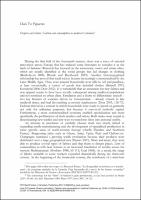Chapter Drapers and tailors. Fashion and consumption in medieval Catalonia
| dc.contributor.author | To-Figueras, Lluís | |
| dc.date.accessioned | 2022-06-01T12:29:31Z | |
| dc.date.available | 2022-06-01T12:29:31Z | |
| dc.date.issued | 2022 | |
| dc.identifier | ONIX_20220601_9788855185653_787 | |
| dc.identifier.uri | https://library.oapen.org/handle/20.500.12657/56603 | |
| dc.description.abstract | The range of textiles available in markets across the western Mediterranean expanded significantly during the thirteenth century. Cloth retailers, or drapers, constituted a fundamental link between merchants and consumers, using a network of local markets with specific spaces for selling cloth. They were able to sell a wide range of commodities, including Flemish and French woollens, to satisfy a growing demand. Between 1250 and 1350, there were also tailors almost everywhere, some at the permanent service of an aristocratic court, such as the kings of Aragon, but most of them worked as independent entrepreneurs offering their services in exchange for specific payments. Therefore both drapers and tailors formed small partnerships and frequently used credit in order to reach all levels of medieval society. | |
| dc.language | English | |
| dc.relation.ispartofseries | Datini Studies in Economic History | |
| dc.subject.other | Draper | |
| dc.subject.other | tailor | |
| dc.subject.other | cloth | |
| dc.subject.other | retail | |
| dc.subject.other | market | |
| dc.title | Chapter Drapers and tailors. Fashion and consumption in medieval Catalonia | |
| dc.type | chapter | |
| oapen.identifier.doi | 10.36253/978-88-5518-565-3.05 | |
| oapen.relation.isPublishedBy | bf65d21a-78e5-4ba2-983a-dbfa90962870 | |
| oapen.relation.isbn | 9788855185653 | |
| oapen.series.number | 2 | |
| oapen.pages | 20 | |
| oapen.place.publication | Florence |

